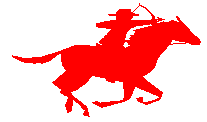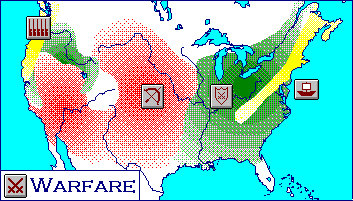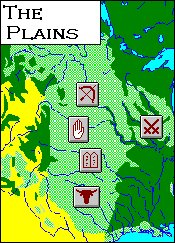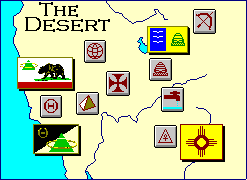Horse Archers

Because it combined the mobility and long distance killing power that soldiers with a memory of indutrial era wars had come to expect, the horse archer was the first medieval fighting style to emerge after the collapse of civilization. For a few centuries, it dominated the old United States, until it was discovered that large warhorses carrying heavily armored knights could often stand their ground against an attack of horse archers; however, it was only in the settled communities of the forest zone that there was enough grain to feed these large horses, so the armies of archers on grass-fed ponies remained dominant on the open prairie.
Among the nomadic herdsmen of the plains and desert, just about every adult male (or roughly a quarter of the population) is trained in the arts of war simply because the management of a herd was so much like battle itself. The cowboys circle the herd on fast ponies, leading it in a chosen direction, splitting it into smaller sections and selecting a few head of livestock to pick off for the day's meal with a couple of well-aimed arrows. The techniques for slaughtering cattle and sheep work just as well for slaughtering people. The archers ride up close enough to send a volley into the massed enemy, and then veer off before the enemy can retaliate. They keep this up all day, thinning the enemy ranks and maybe creating gaps that can be slowly widened, wedging the mob apart into smaller, bite-sized groups.
Adding to the military strength of the nomads is their incredible long-distance mobility. Armies of the forest zone are tied to the land -- both defending it and working it -- and they can only spare a handful of their adult males for long distance campaigning. The nomads, however, can simply uproot their entire nation and drag it along wherever they go. In the quiet times between battles, they can still tend their herds and their families as if they were at peace, and they can thrive wherever their is enough pasture to support them.
It is the lack of pasture that limits the depth of nomadic invasions. As the invaders penetrate deeper into the farmlands, they leave a trail of devastation behind them. If the abandoned farms revert to grasslands, then the nomads can settle in for a long stay, but if the land reverts to forest, then there will soon be no forage for their herds. The nomads then must retreat to the high plains, and the farmers move in to reclaim the empty land.



Last Updated April 1999
Copyright © 1999-2003 Matthew White